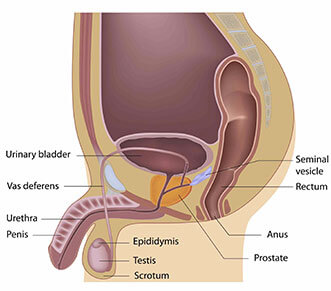Despite being a serious disease, most cases are at an early stage when detected, or they grow slowly. This means they have a low risk of spreading and may not even require any immediate treatment or surgery, thus promoting and maintaining a high level of quality of life and avoiding the patient suffering from adverse events such as sexual, urinary, and bowel dysfunction after undergoing aggressive and sometimes unnecessary treatment.
For this reason, it is important to focus on obtaining a precise diagnosis of the cancer case, which enables doctors to identify where and how the lesion is located, and its stage; and therefore provide appropriate answers to every patient.
Today, biopsies are the only diagnostic test that can confirm the presence of prostate cancer and evaluate prognosis.
The prostate: function and anatomy
The prostate is a walnut-sized gland located inside a man’s body between his bladder and rectum. The prostate surrounds the urethra, the passageway of the penis through which urine and semen pass. The prostate fulfills a primary function in urination through the presence of sphincters upstream and downstream.

It also has a sexual function, as it is responsible for the preparation of semen and ejaculation. That is why changes in a man’s urinary or sexual function may indicate prostate cancer.
There are three zones within a normal prostate: the posterior peripheral zone and two anterior symmetric lobes that make up the adenoma. The latter tends to grow with age (benign hypertrophy). Sometimes this can cause problems that are common in older men and are not always symptoms or signs of cancer.
What are the symptoms?
Prostate cancer may not cause any signs or symptoms in its early stages. In advanced stages, some symptoms of prostate cancer might include:
- Feeling a frequent or sudden need to urinate
- Difficulty in urinating (for example, trouble starting or inability to urinate, or poor flow of urine)
- Discomfort when urinating
- Blood in semen or urine
- Discomfort in the pelvic area
- Bone pain
- Erection problems
Such symptoms do not indicate the presence of cancer! However, if you experience any of these signs, the first step is to make an appointment with your primary care doctor.
How is prostate cancer diagnosed?
Most prostate cancers are first discovered during screening because they have no symptoms at an early stage. However, more advanced cancers may cause some urinary or sexual problems that can reveal the disease. If prostate cancer is suspected, certain tests will be needed, as well as a final biopsy that will eventually confirm whether or not cancer is present.
Prostate cancer screening is currently carried out in these ways: by a Digital Rectal Exam (DRE), a PSA blood test, or an MRI scan.
PSA blood test

This test measures the amount of Prostate Specific Antigen in the blood. PSA is a protein produced by cells in the prostate.
A man with prostate cancer often presents elevated levels of PSA. However, some men with prostate cancer may have low PSA levels. In addition, PSA levels can also be raised by several other medical conditions unrelated to cancer.
Digital Rectal Exam (DRE)

During a Digital Rectal Exam, the physician inserts a gloved, lubricated finger into the rectum and examines the prostate for any irregularities in size, shape, and texture that might be a sign of cancer
MRI before biopsy for prostate cancer diagnosis
Over the past 10 years, Magnetic Resonance Imaging (MRI) has progressed and shown high sensitivity and specificity for prostate cancer. However, this technique requires the expertise of the radiologist, who works in collaboration with the urologist and the pathologist to locate and define the patient’s disease.
The introduction of MRI in prostate cancer management has significantly improved the sensitivity and specificity of diagnostic tests for high-risk lesions. An expert radiologist interprets the Multiparametric MRI and will then identify and contour the lesions and assign them a score from 1 to 5, known as the PI-RADS score.
Prostate biopsy, the only diagnostic test to confirm prostate cancer
Since MRI cannot detect and characterize 100% of lesions or assess the exact tissue extension, biopsy remains the only complementary method that can confirm the diagnosis of prostate cancer. However, when MRI reveals a high negative predictive value, an expert examination concluding the absence of lesions may lead to a deferral of a biopsy.
KOELIS® technology for prostate cancer diagnosis
For over a decade, KOELIS® has expertly assisted urologists and radiologists worldwide in their routine clinical practice by providing them with the latest technology.
In order to give personalized answers to every patient regarding their quality of life, we’ve developed KOELIS Trinity®, the first image-based mapping system.
This system allows physicians to perform precise and targeted transperineal or transrectal MRI/US fusion-guided biopsies under local or general anesthesia.
“Quality management of patient diagnosis”
It is equipped with the exclusive Organ-Based Tracking technology, which improves the accuracy of the biopsy. Without changing standard clinical practices, this technique provides increased quality control over biopsy localizations. A precise, individual prostate biopsy mapping is imperative and highly valuable for the accurate diagnosis and subsequent management of each patient.
 United States
United States
